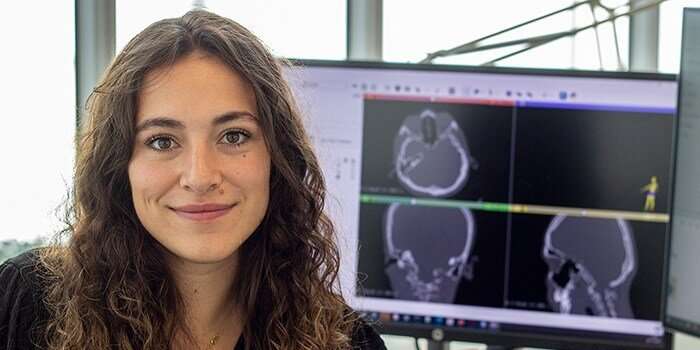
One out of five patients with hearing loss, severe hearing impairment or who were born deaf, have deformations in the inner ear, and could benefit from having an advanced hearing aid known as a cochlear implant (CI) implanted. Examinations of the labyrinthine structure of the inner ear are made by CT scan, although interpretation of the images is very difficult, and can delay or completely rule out the treatment.
DTU Ph.D. student Paula López Diez is studying how artificial intelligence (AI) can be used for image analysis. AI will make it faster for doctors to determine whether an implant will be suitable.
“It’s highly motivational to see what CI means for patients, and to know that my research will be able to help them. AI is now used in every way possible, and will become even more widespread, because it works. We should prioritize the use of AI research within medical science, in order to improve diagnosis and treat patients earlier,” says Paula.
Software to help with complicated operations
A cochlear implant consists of exterior and interior parts. Externally, an audio processor placed behind the ear picks up sound, which it digitalises and transfers via a transmitter located on the skull to an implant receiver just under the skin. The receiver converts the digital data to an electronic signal, which is then sent to a series of electrodes implanted in the cochlea. The electrodes stimulate the auditory nerve, enabling the brain to perceive sound.
The actual operation is complicated, as surgeons must drill a hole in the skull in order to implant the receiver and electrodes, but if they touch a facial nerve or an electrode is too close to a facial nerve, the patient could experience paralysis, tics and pain. And the implant will not work if the electrode is placed incorrectly in relation to deformations. It therefore requires a high degree of precision, and the surgeons need detailed knowledge of deformations in the ear.
“The objective is to develop software to which doctors upload the CT scans, and which is able to automatically identify the different types of typical deformations in the structure of the inner ear. The software should potentially be developed to provide an assessment of whether a cochlear implant would work, and indicate to the surgeon how, and from which angle, to perform the operation,” says Paula.
“Many ENT doctors are unaware of deformations in the ear, as there are so few patients who have them. And no two deformations are identical, which means the algorithm will also be able to make a difference in this area,” she adds.
Paula is employed in the research section Visual Computing at DTU Compute, where the scientists are experts in using Artificial Intelligence such as machine and deep learning in image analyses. Using her knowledge of the ear’s structure, Paula trains her mathematical model to identify the special characteristics in CT scan images.
She recently published her first research results along with colleagues from DTU and the partner in the Ph.D. project, Oticon Medical. The results confirm that AI makes it possible to identify the auditory nerve and facial nerves in scanned images.
AI trains on data from Russian patients
Due to the fact that there is limited data available for patients with deformation of the inner ear, DTU uses data from the National Medical Research Center for Otorhinolaryngology of the Federal Medico-Biological Agency of Russia in Moscow. Oticon Medical already collaborates with the head of the hospital, professor Khassan Diab, who is a specialist in the field.
Collaboration with Russian research institutes is a first for the DTU department. According to associate professor and Ph.D. counselor Rasmus Paulsen, DTU now has the opportunity to train its mathematical models on a unique dataset.
“It’s extremely important to have access to data that reflects the enormous variation in patients with deformation of the inner ear, as well as to receive expert input for the optimum surgical procedure to be able to plan operations. Khassan Diab’s research center covers a huge geographical area, and therefore his clinic treats many more patients than most others. It’s invaluable to have access to this data along with clinically relevant parameters, such as the surgical techniques and results of implant operations.”
Paula will be visiting the hospital in Moscow during the spring to experience how the doctors work on a daily basis and see how they generate data.
“I’m an engineer and mathematician who works with mathematical models, and have never studied anatomy. Of course I have considerable knowledge of the ear, but it’s always good to be able to get out and gain an insight into what doctors need, and how our algorithms can help.”
Oticon Medical: Innovation for patients
Oticon Medical has high expectations for the Ph.D. project, explains co-counselor François Patou, whose position as Senior Translational Research Manager involves deploying scientific know-how into practice more rapidly:
Source: Read Full Article



